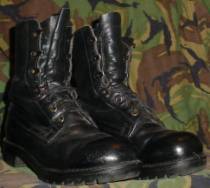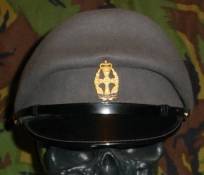HEADGEAR AND BOOTS
Berets were introduced initially into the Royal Tank Corps in the First World War and their use became more widespread
in the British Army during and after the Second World War to replace side caps for wear with combat uniforms when
protective headgear was not being worn. Originally, khaki was the standard colour for all units, but specialist units
adopted coloured berets to distinguish themselves.
The colours are as follows:
| Khaki | Foot Guards |
| Khaki: | Honourable Artillery Company |
| Khaki: | Princess of Wales's Royal Regiment |
| Khaki: | Royal Anglian Regiment |
| Khaki: | Princess of Wales's Royal Regiment |
| Khaki: | Duke of Lancaster's Regiment |
| Khaki: | Royal Welsh |
| Khaki: | Green Howards |
| Khaki: | Royal Gibraltar Regiment |
| Light grey: | Royal Scots Dragoon Guards |
| Dark grey: | Queen Alexandra's Royal Army Nursing Corps |
| Brown: | King's Royal Hussars |
| Brown: | Royal Wessex Yeomanry |
| Black: | Royal Tank Regiment |
| Dark (Rifle) green: | The Rifles |
| Dark (Rifle) green: | Royal Gurkha Rifles |
| Dark (Rifle) green: | Small Arms School Corps |
| Dark (Rifle) green: | Essex Yeomanry |
| Maroon: | Parachute Regiment |
| Maroon: | Airborne trained soldiers attached to 5 Airborne Brigade |
| Beige: | Special Air Service |
| Emerald grey: | Special Reconnaissance Regiment |
| Commando Green: | Commando qualified personnel serving in Commando units or the Special Boat Service |
| Cypress Green: | Intelligence Corps |
| Sky blue: | Army Air Corps |
| Scarlet: | Royal Military Police |
| Green: | Adjutant General's Corps |
| Navy blue: | all other Army units (except Scottish and Irish line infantry regiments) |
Beret badges come in two distinct types; Cloth badges are worn by officers and anodised metal badges are worn by
enlisted personnel, with the exception of the SAS, in which officers and enlisted wear cloth badges.
ROYAL ENGINEERS (OTHER RANKS)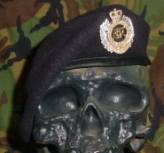 |
RE COMMANDO (OTHER RANKS)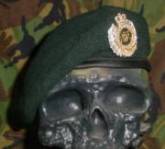 |
ROYAL ENGINEERS (OTHER RANKS) SUBDUED
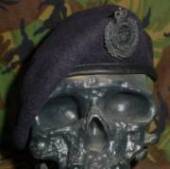
ROYAL ENGINEERS (OFFICER)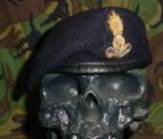 |
ROYAL ENGINEERS AIRBORNE (OFFICER)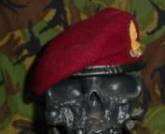 |
|
QARANC (ENLISTED)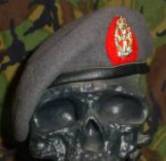 |
SAS (OFFICER)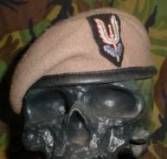 |
In addition to the different coloured berets, some Regiments and Corps wear a coloured backing on the beret behind the cap badge.
The colours are as follows:
| Scots Dragoon Guards: | Yellow |
| 4/7 Dragoon Guards: | Maroon |
| 5 Inniskilling Dragoon Guards: | Green |
| Royal Hussars: | Crimson |
| 14/20 Hussars: | Primrose |
| 15/19 Hussars: | Red |
| Royal Scots: | Red |
| Devon & Dorset: | Green |
| Light Infantry: | Red |
| Royal Regiment of Wales: | Green |
| Worcesters & Foresters: | Green |
| Duke of Wellingtons Regiment: | Red |
| Queen's Lancashire Regiment: | Primrose |
| Staffordshire Regiment: | Buff |
| Army Air Corps: | Dark Blue |
| Royal Army Medical Corps: | Dull Cherry |
| Royal Army Dental Corps: | Green |
| Army Physical Training Corps: | Red & Black |
| Queen Alexandra's Royal Army Nursing Corps: | Scarlet |
| Women's Royal Army Corps: | Beech Brown |
| Scottish Division: | Regimental Tartan backing on Tam O' Shanter |
Most Regiments and Corps of the British Army wear a peaked cap in Numbers 1 and 2 Dress, designated: "Cap, Forage, Peaked"
the exceptions being:
The Royal Tank Regiment, Royal Regiment of Fusiliers, Army Air Corps, Parachute Regiment, SAS, Intelligence Corps
and 4/73 Battery RA who wear berets.
The Royal Regiment of Scotland wear a regimental Glengarry with cockfeathers taken from the former ceremonial
uniform of the Royal Scots. The Royal Irish Regiment wear the Caubeen and the Brigade of Gurkhas wear a round Kilmarnock
cap in No 1 dress and the Slouch hat in No 2 Dress.
The Queen's Royal Hussars wear a tent hat in No 2 Dress.
The "Cap, Forage, Peaked", has a cap band which may be coloured, a crown which may have coloured piping or a regimental/corps
colour and a patent leather peak and chinstrap. The chinstrap is usually secured above and across the peak and secured
at each end by a small button of the appropriate Regimental or Corps pattern.
The Cap, Forage, Peaked is worn with No1, No3, No10 and No11 Dress on all occasions, and with No2 and No6 Dress on
formal occasions.
Beret badges come in two distinct types; Cloth badges are worn by officers and anodised metal badges are worn by
enlisted personnel, with the exception of the SAS, in which officers and enlisted wear cloth badges.
RE, MENS (OTHER RANKS)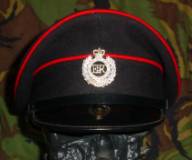 |
RE, MENS (OFFICER)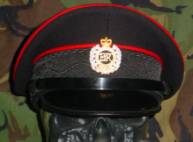 |
||
RAMC, MENS (OFFICER)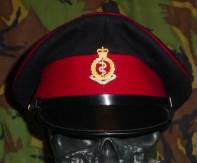 |
RAMC WOMANS (OTHER RANKS)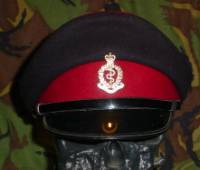 |
||
|
QARANC, WOMANS (OTHER RANKS)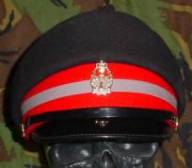 |
Officers and Warrant Officers Class 1, in some regiments are also required to wear a Khaki version of the
Cap, Forage, Peaked often called the "Service Dress Cap" designated: Cap, Khaki, Peaked (Officers), on all occasions
other than when in No1, No3, No10 and No11 Dress. The design of this dates back to the cap worn in the field until
replaced by the steel helmet during the First World War.
ROYAL ENGINEERS CAP, KHAKI, PEAKED (OFFICERS)
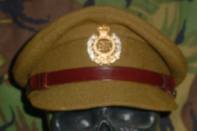
The Mk V Steel Helmet has it's origins in 1944 as the Mk III helmet replacing the "Brodie" type helmet. The Mk III was
itself replaced after WW2 by the Mark IV helmet, which differed only in the placement of the rivets securing the
chinstrap. The main differences were that the rivets attaching the chinstrap to the helmet were placed much higher up
on the shell to give less "helmet bounce". The Mark IV helmet was eventually replaced by the Mark V, which looked similar
to the MK IV, but had a more padded liner.
MkV HELMET
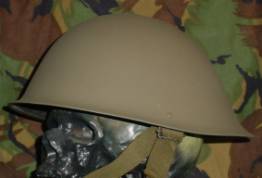
The Mark V was used until the issue of the Mk 6 Ballistic Nylon (nylon fibre)
helmet in 1987.
The Mk 6 helmet or Kevlar Helmet Mark 6, is designed to accept modern ear protection, personal radios, and respirators.
The helmet is manufactured by NP Aerospace, weighs 1.4kg, and claims to have an "almost unlimited service life" by the
manufacturer.
Mk6 HELMET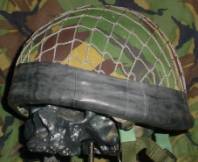 |
Mk6 HELMET WITH SCRIM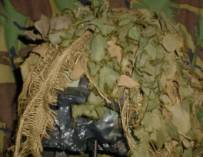 |
MK6 HELMET INTERIOR
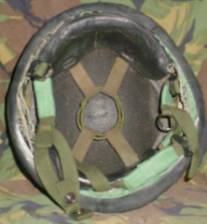
The helmet in its default configuration is dark green. The army use coloured covers to camouflage the helmet and
adapt it to different environments. Covers include the British DPM in temperate and desert patterns, a pure white cover
for arctic environments and sky blue for United Nations operations. It is sometimes referred as the "battle bowler" a
term first used for the Brodie helmet. The Mk 6 is often mistakenly thought to be made out of Kevlar when in fact it is
constructed of "ballistic nylon" - nylon fibre.
The British Army issued quiet rubber-soled boots for specialists and ammunition storemen
(because they produced no sparks), to replace Ammunition Boots, but finally adopted the DMS
(direct moulded sole) boot in 1958.
BOOTS, DMS & PUTTEES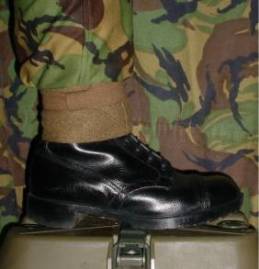 |
DISTINCTIVE DMS SOLE PATTERN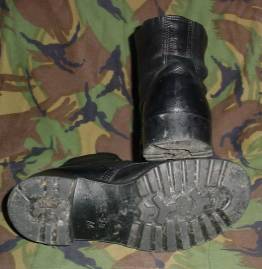 |
It was still an ankle boot, which was worn with woollen Puttees, wrapped around the
top of the boot for additional ankle support. A grained leather upper, smooth toe cap, directly moulded sole (DMS).
These were the general service issue boot up until the Falklands conflict. They were issued, two pairs per man,
but from 1958 -1967, one pair of DMS and one pair ammunition boots (for parade) were the standard issue. The major
concern with the new boot was, the tendancy for water to leak into the boot around the tongue.
In 1983, after the appearance of “TrenchFoot” in the Falklands campaign, that the BCH (Boots Combat High) became the standard issue.
BOOTS COMBAT HIGH
